All Management Events
- Dr Kakumani K C Deepthi September 20, 2022
- Mental health of school students during the COVID-19 pandemic in India September 20, 2022
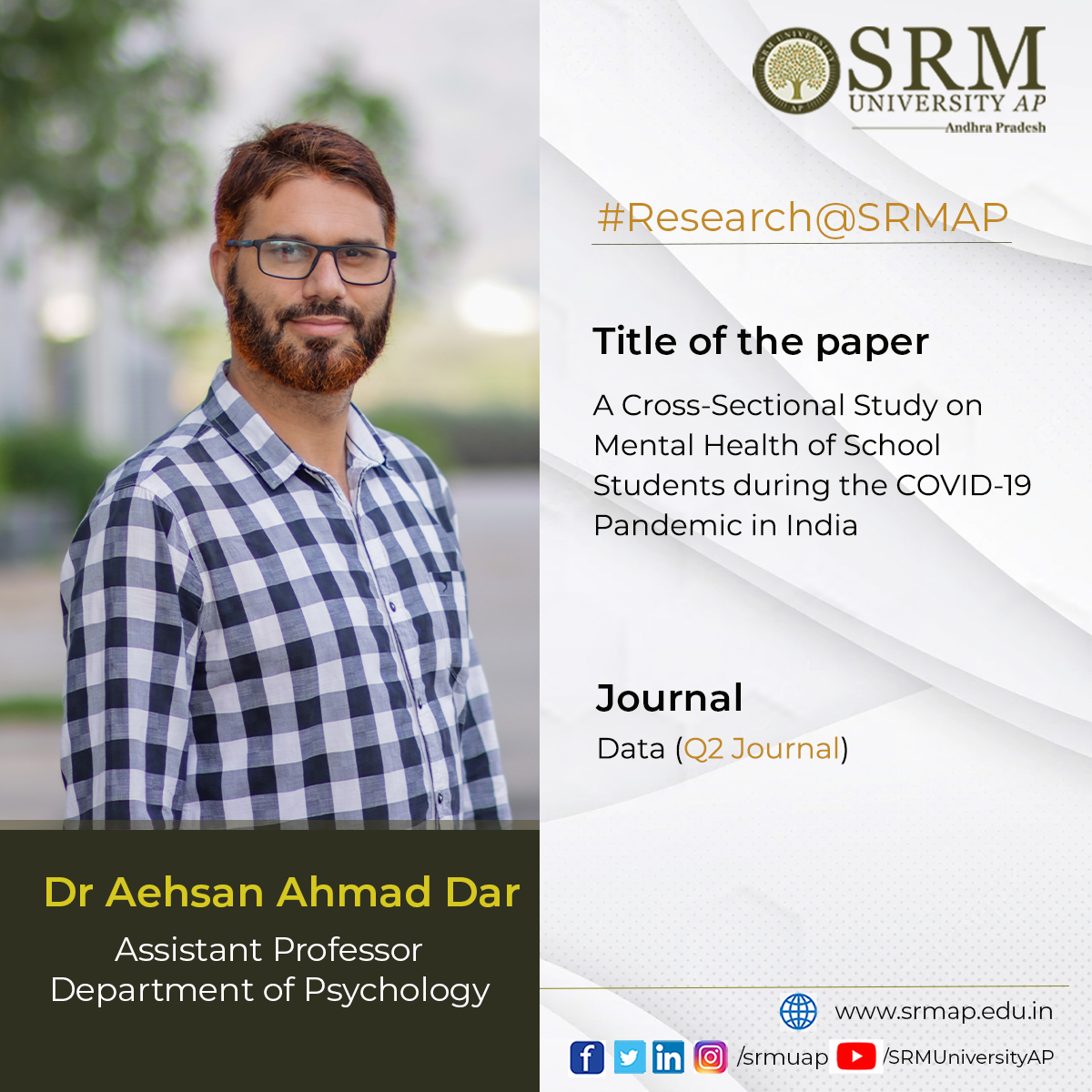
Dr Aehsan Ahmad Dar, Assistant Professor, Department of Psychology, published the article titled “A Cross-Sectional Study on Mental Health of School Students during the COVID-19 Pandemic in India” in the journal Data in collaboration with academicians from different universities across the country and abroad.
The present study estimated the mental health of school students during the COVID-19 pandemic. The findings revealed that the COVID-19 pandemic caused stress which increased the levels of anxiety and depression among the students. However, social support from family and friends was found to be a protective factor for mental health.
The findings of the research will serve as a reliable source of information for mental health professionals and policymakers to better understand the impact of the COVID-19 pandemic and other traumatic experiences on mental health. Therefore, necessary efforts are suggested to provide mental health support services to prevent the development of mental disorders.
Dr Aehsan’s future research plan is to study the mental health of youth and ascertain its risk and protective factors. About 19% of the world’s children live in India, which constitutes 42% of the total Indian population, and nearly half of these children are vulnerable and need care and protection. Due to various traumatic experiences, stress has increased among young people resulting in the development of various physical and mental disorders.
His research will focus on the pathogenic (posttraumatic stress disorder, depression, anxiety, somatization) and salutogenic (posttraumatic growth and resilience) consequences of trauma to help the youth withstand adverse experiences to develop psychological competence. The research will provide insights into the mental health status of youth that would be helpful for the administration, policymakers, and other voluntary organizations to understand effective ways to devise and implement the best intervention programs for maximizing mental health protective factors and minimizing its risk factors.
Continue reading → - Dr Deblina Dutta September 20, 2022
- Industry visit to Fopple Drone Tech Pvt Ltd September 20, 2022
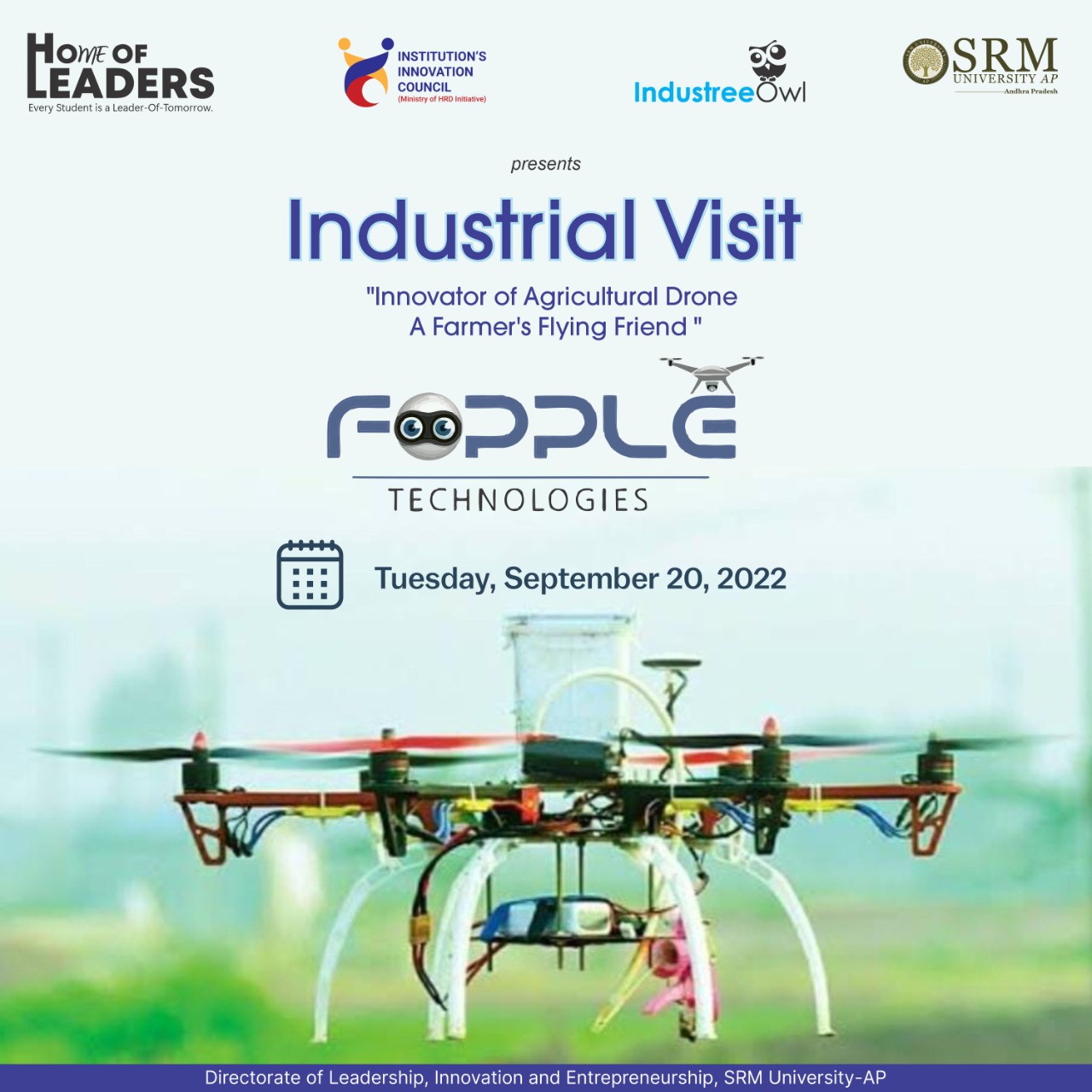
The Directorate of Entrepreneurship and Innovation is organising its first start-up visit to Fopple Drone Tech Pvt Ltd, a revolutionary agricultural machinery manufacturer in Andhra Pradesh. The programme is scheduled on September 20, 2022, under the leadership of the student community – Industree Owl. The visit will be flagged off by the honourable registrar Dr R Premkumar.
Industrial visit is an integral component of the active learning pedagogy offering students practical exposure in their field of studies. Observing the working culture of an industry from close quarters will help students keep abreast of the latest technologies, corporate strategies, and current trends, being followed in leading companies.
Fopple Drone Technologies, founded by Mr Ambula Gopi Raja, gave rise to the nation’s first agriculture drone. These drones spray fertilizers in a perfect manner as designed by the innovator. They can cover up to fifty acres of land in a single day. With a smaller number of farming labour available in the rural areas, such innovative accessories play a vital role in the sustenance of this dwindling tribe of farmers. In addition, they also save time and spray uniformly unlike humans. The business model of this start-up is unique.
The Directorate of Entrepreneurship and Innovation spares no effort in connecting students with industrial networks. Industrial visits are excellent opportunities to interact with business professionals and experts that may help them in building necessary leadership qualities and management skills.
Industree Owl is one of the student communities operating as part of the Home of Leaders, managed by the Entrepreneurship directorate. The community works with corporates and provides a platform to check the industry readiness of students via events like competitions, conferences, and hackathons. The tentative outcomes of the scheduled industrial visit are as follows.
- Practical exposure to a startup and the challenges – narration from the founder.
- Meeting the founder, his team and learning more about the assembling unit and the research lab.
- Experience the latest drone technology and the various applications in the industry.
- Opportunity to start a Drone Centre of Excellence at SRMAP
- Experience the real customers and the scope of the technology in India in the next 3-5 years
- Meeting the farmers on the field and understanding the true meaning of a “problem statement”.
- Design a solution and inspiration to start a project/ venture in the same domain.
- Introduction to hackathon: best practices September 19, 2022
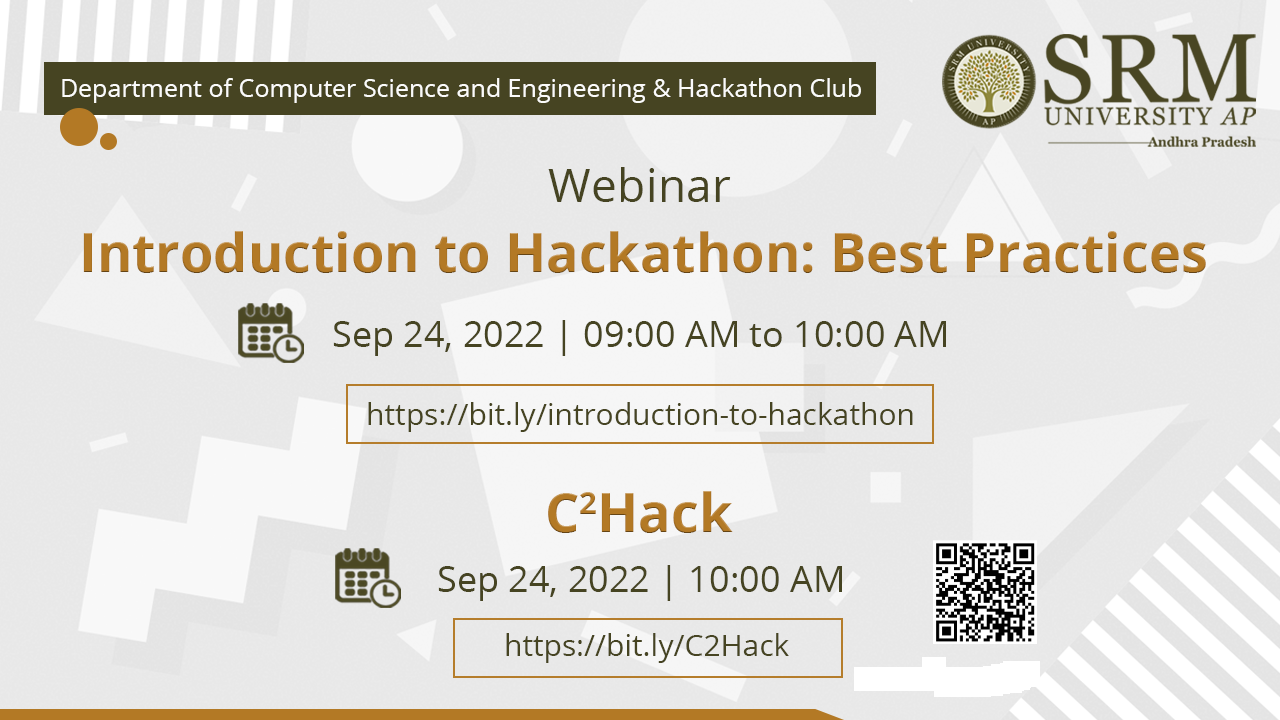
The Department of Computer Science and Engineering in association with the SRM AP Hackathon club is organising a webinar titled Introduction to Hackathon: Best Practices from 9 am to 10 am, followed by a 24-hour internal hackathon C2Hack at 10 am on September 24, 2022.
A hackathon is a social coding event bringing together computer programmers and other technology enthusiasts together to conceive a new software programme or redesign an existing programme to enhance its performance. Hackathons present a constructive platform for developing prototypes for various applications and programming languages or for providing solutions to real-life challenges ranging from educational technology to disaster management.
Hackathons are thus classified into different types based on their objectives and themes. Having a well-defined set of rules is a necessity while organising a hackathon. The webinar intends to introduce students to the fundamentals of hackathon and some of the effective practices one may follow while participating in a hackathon. Students will also be given the opportunity to test their hacking skills in an internal hackathon C2Hack following the session.
Join the webinar and learn how to use your tech genius to find solutions to the greatest of real-life challenges. Every hackathon is a smart route to actualise your ideas into innovations.
Continue reading → - Freshers’ orientation programme- 2022 September 19, 2022
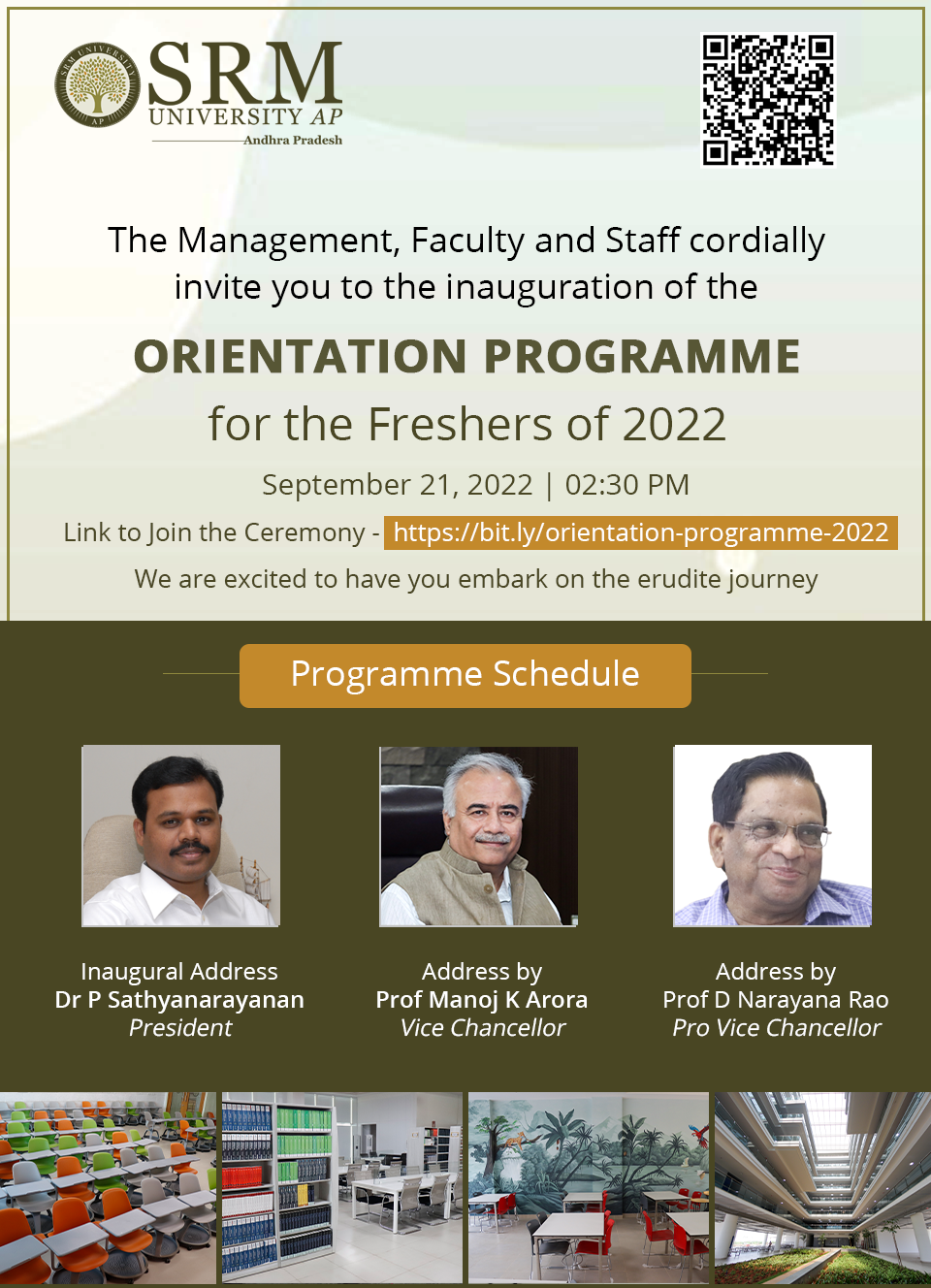
SRM University-AP is excitedly looking forward to the arrival of the new batch of the year 2022 on September 21, 2022. The inaugural ceremony of the freshers’ day orientation programme is scheduled on the day at 2.30 pm in the august presence of the university dignitaries; Honourable President Dr P Sathyanarayanan, Vice-Chancellor Prof Manoj K Arora and Pro Vice-Chancellor Prof D Narayana Rao.
An array of distinguished talks and motivational sessions has been arranged during the two-week-long programme to gear up the students as they are all set to embark on a new phase of their academic life at the university. Students will also be acquainted with the unique culture of the research-intensive campus, an overview of their university life, and the infrastructure and facilities available at the university.
There will be introductory sessions on various university departments such as Examination, Student Affairs, Information Technology & Knowledge Management and Corporate Communication, Academic Affairs, NSS, Campus Life, Centre for Skill Development, Student Counselling, and so on to help students understand how each department works. Deans and faculty from the departments will also speak to students to provide an overview of the department, its scope, and opportunities.
Recreational sessions in collaboration with Heartfulness Institute have also been scheduled as part of the orientation programme.Leading heartfulness practioners; Mr Ramesh Krishnan, Mr V V S Prasad and Mr Sathish Desai will address the students on the significance of peace and mental health in academic life
During the interactive sessions the following speakers will address the students on various topics of interest:
- Mr Kundana Kumar Lal, President VITTI, Research Foundation
- Dr Jaya Prakash Narayan, IAS, Retd.
- Ms KGV Saritha IPS
- Shri V V Lakshminarayana, IPS, Retd
- Mr Prabhu Bala Srinivasan, Vice President – Flipkart
- Prof P K Singh, Director – IIM Tiruchirappalli
Programme Schedule: Schedule for Freshmen Orientation Programme-2022
Link to Join: https://bit.ly/orientation-programme-2022
Continue reading → - Vector Bundles: Sixth distinguished lecture from the Department of Mathematics September 19, 2022
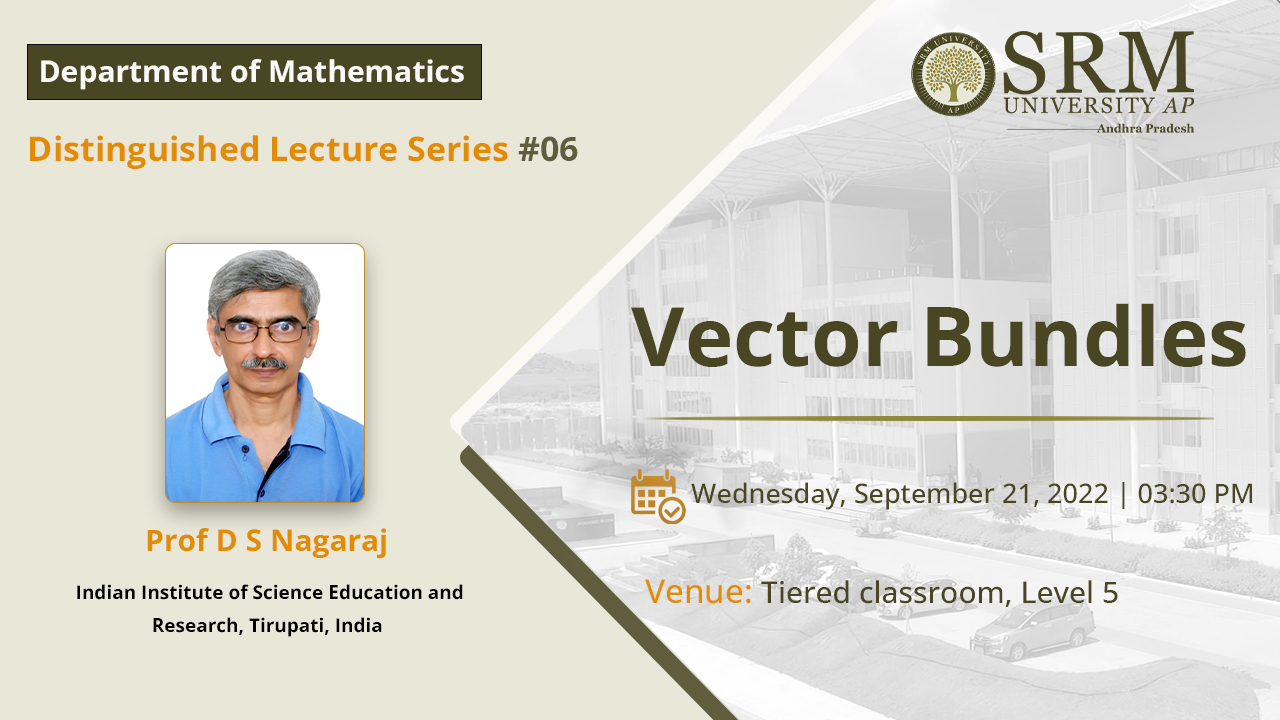 The concept of vector spaces and linear maps between vector spaces are used in all branches of mathematics. The Department of Mathematics is organising the sixth distinguished lecture Vector Bundles in affiliation with the Indian Institute of Science Education and Research, Tirupati, India. Renowned Indian Mathematician Prof D S Nagaraj is the keynote speaker of the lecture.
The concept of vector spaces and linear maps between vector spaces are used in all branches of mathematics. The Department of Mathematics is organising the sixth distinguished lecture Vector Bundles in affiliation with the Indian Institute of Science Education and Research, Tirupati, India. Renowned Indian Mathematician Prof D S Nagaraj is the keynote speaker of the lecture.Date: September 21, 2022
Time: 3.30 PM
Venue: Tiered classroom, Level 5
The talk will explain the concept of vector bundles and mapping between vector bundles, a natural generalisation of vector spaces, and linear mapping between vector spaces. The concept of vector bundles and mapping between them is helpful in several advanced branches of mathematics.
About the speaker
Prof D S Nagaraj did his PhD from the Tata Institute of Fundamental Research (TIFR), Mumbai. He was a professor at the Institute of Mathematical Science (IMSc), Chennai, one of the premier research institutes in India. After his retirement in 2018 from IMSc, he joined as a professor at IISER, Tirupati, and currently is the head of the Mathematics Department there. A conference on the occasion of his sixtieth birthday was held at IMSc in 2018 to celebrate his works. His areas of interest include Algebraic Geometry, Commutative Algebra, and Number Theory. His profound scholarship on the subject influenced many young scholars who later became well-established mathematicians. He is exceptionally generous and approachable to young students who would try to learn algebraic geometry for the first time. He has significantly impacted a generation of mathematicians as a researcher and a great teacher. He was elected as a fellow of the Indian academy of sciences in 2010 and 2017.
Join the lecture through the zoom link!
Continue reading → - The Newsmakers: A session with Ms Pragya Gupta September 16, 2022
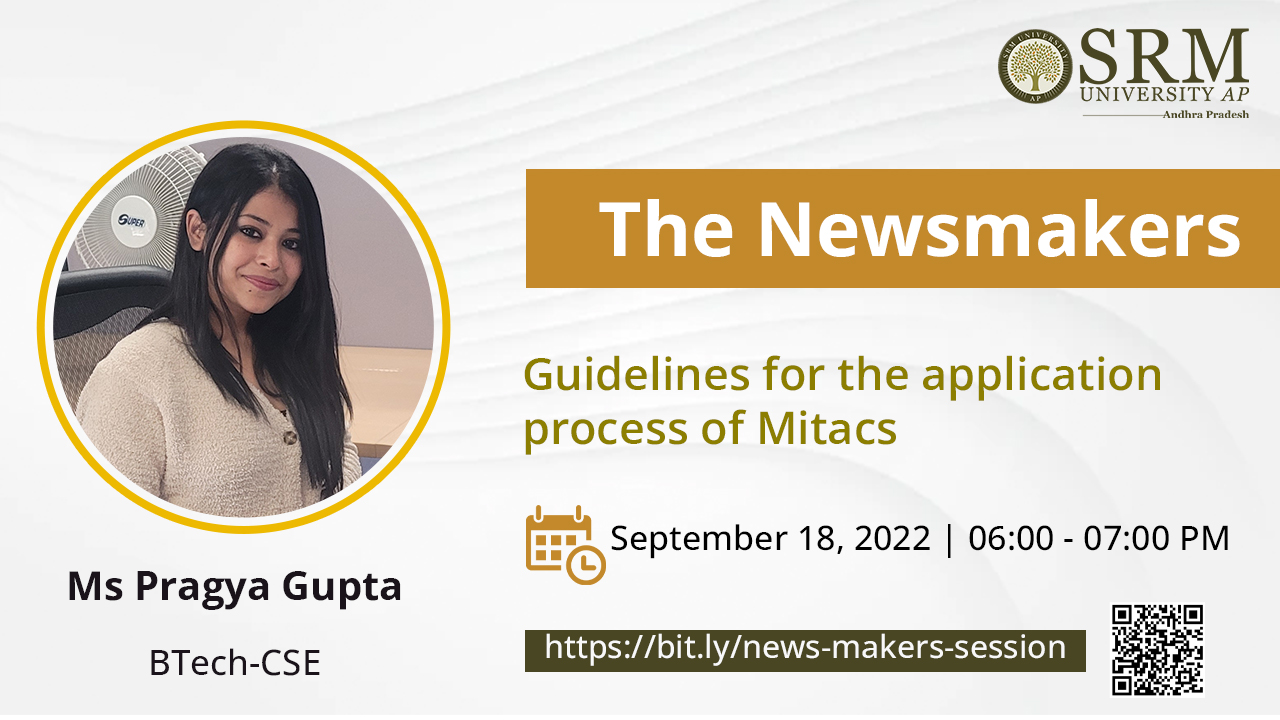
The Department of Student Affairs brings to you another segment of The Newsmakers session with Ms Pragya Gupta. Ms Pragya was one among the two students from the Department of Computer Science and Engineering who secured the coveted Mitacs Global Link Research Internship. She will deliberate on the topic “Guidelines for the application process of Mitacs”
Date: September 18, 2022
Time: 06.00 pm to 07.00 pm
Mitacs Globalink Research Internship is a highly competitive programme that pairs top-ranked international students having specific research expertise from 15 countries worldwide with faculty at top Canadian academic institutions. This is a twelve (12) week research project of mutual interest between May and October 2022.
As a fully funded programme, Mitacs and AICTE will administer the grant. Students can choose from about 14k+ projects in disciplines like Engineering, Life Sciences, Mathematics, Natural Sciences, Social Sciences, and the Humanities.
Ms Pragya got hold of the opportunity to spend three months at Athabasca University – Edmonton, Canada, as a research intern to work on the project titled “Blockchains for Data Storage and Mining in Learning Analytics”.
Join the webinar with Ms Pragya Gupta to know everything about the Mitacs Globalink Research Internship.
Continue reading → - Occurrence, environmental risks, and biological remediation of Triclosan September 16, 2022
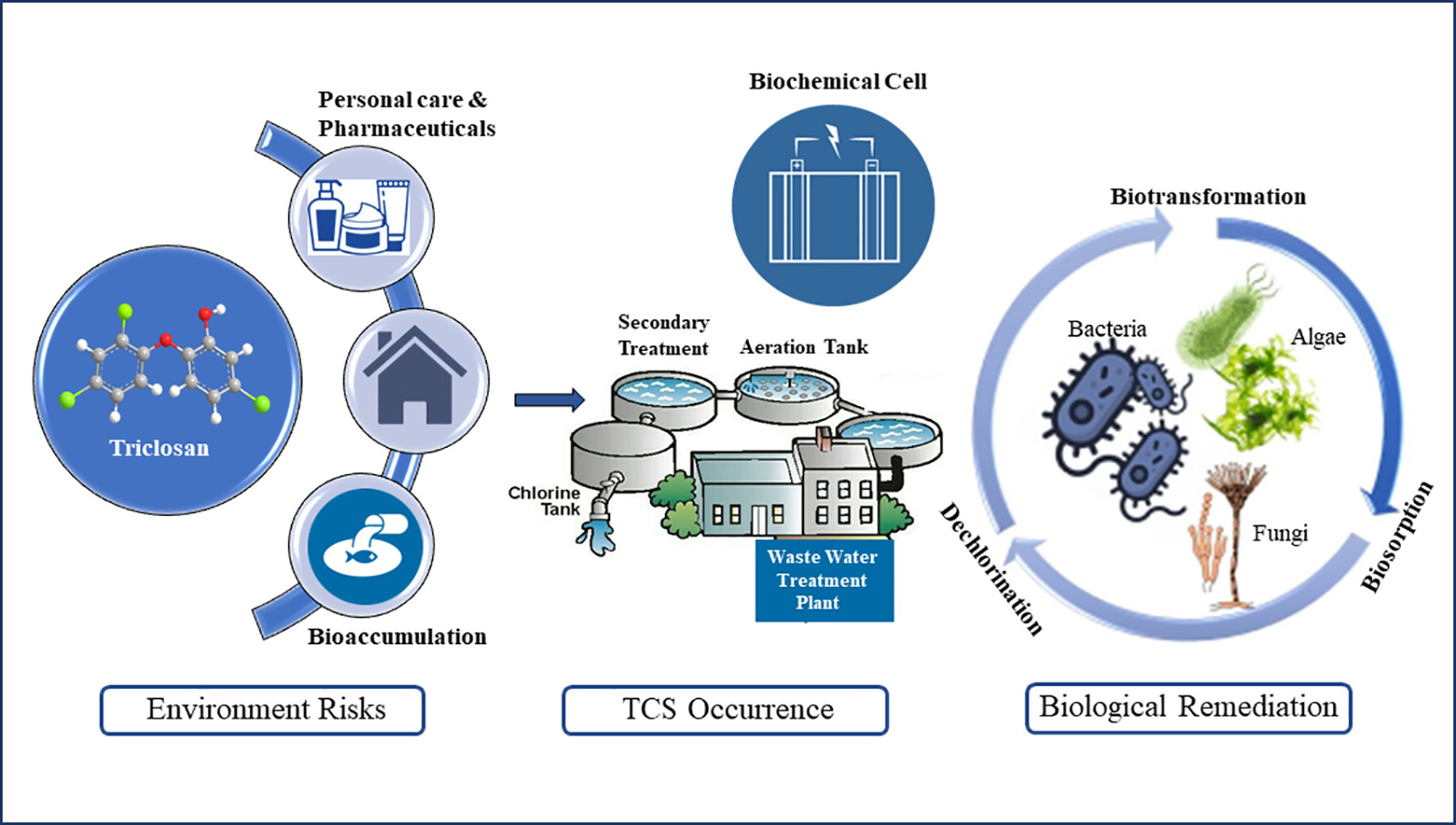
The Department of Environmental Science is glad to announce that Assistant Professor Dr Pankaj Pathak and her PhD Scholar Mr Gopa Nandikesh have published an article titled “Occurrence, environmental risks and biological remediation mechanisms of Triclosan in wastewaters: Challenges and perspectives” in the Journal of Water Process Engineering having an Impact Factor 7.34. The paper was published in collaboration with Dr Lakhveer Singh, Sardar Patel University, Himachal Pradesh.
The paper makes a comprehensive understanding of the disadvantages and consequences associated with the excessive use of Triclosan (TCS), an anti-microbial agent widely used in pharmaceutical and personal care products (PPCPs). The article also suggests various ways to achieve the bioremediation of Triclosan using microbial degraders and the different challenges associated with such practices.
The extensive use of TCS in PPCPs has increased over the past few decades, and its sizeable production and consumption are causing adverse effects on the environment and humans. TCS has been made into the list of emerging micropollutants (EMPs) due to its omnipresence in water resources and even in biological samples such as urine and breast milk. Therefore, it is imperative not only to understand the current status of TCS pollution but their occurrence, exposure routes, and environmental risks to identify remediation technologies for mitigating TCS.
Their research targets to provide cumulative data on the abundance of emerging TCS in water resources and its associated health burdens simultaneously. It is identified that TCS remediation can be achieved through advanced physical and chemical methods such as enzyme oxidation and ozonation. However, there are drawbacks such as high energy consumption and the formation of toxic by-products.
The article endeavours to provide an in-depth understanding of the biological remediation of TCS by microbial degraders as well as its superiority over other remediation techniques. Insights into the various microbial communities such as bacteria, algae, and fungi and their unique bioremediation mechanisms are comprehensively summarised. Moreover, challenges associated with existing bioremediation methods and future perspectives are also discussed in the present work.
Continue reading → - Converting fear into power September 16, 2022
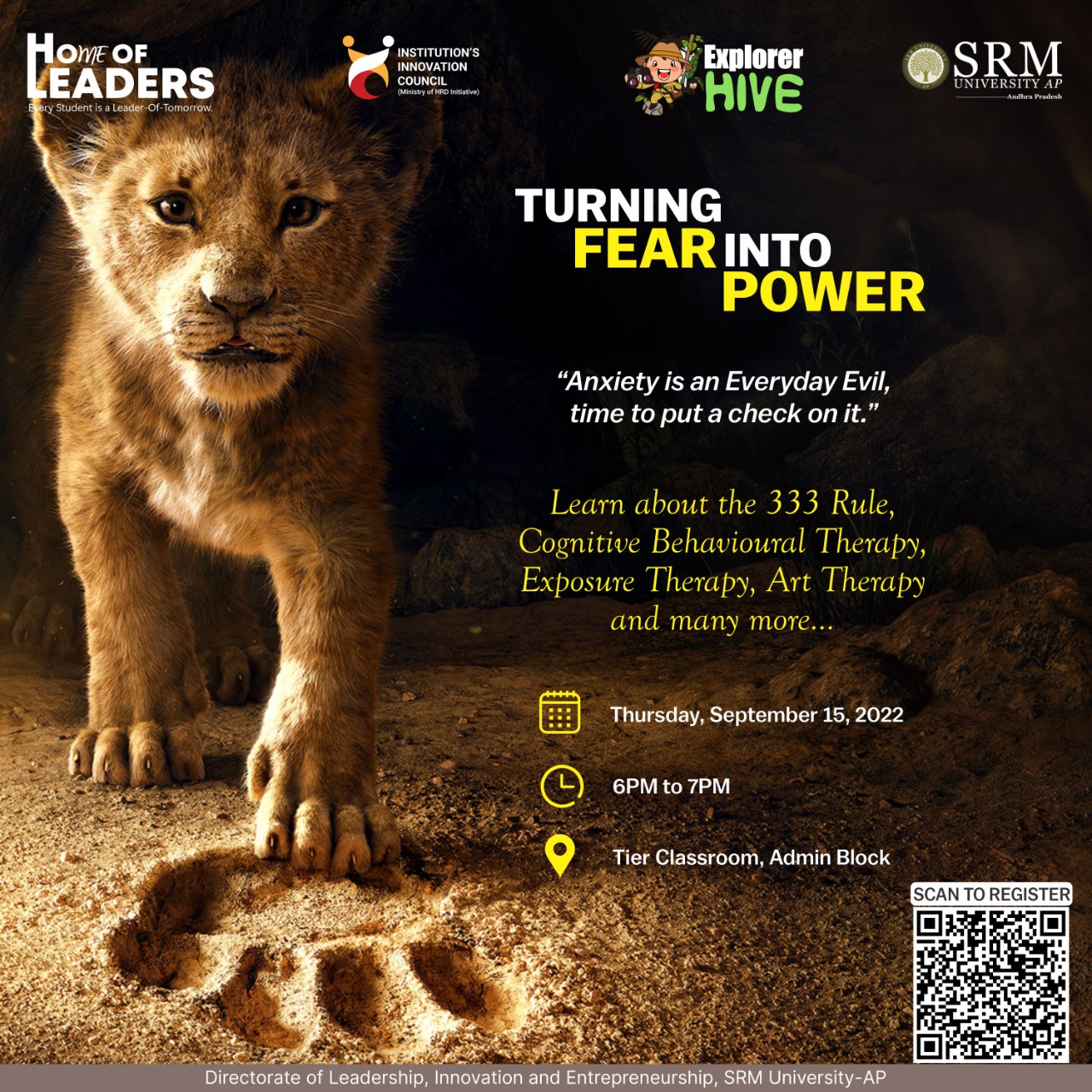 To be a leader, you must act like one and be among leaders, as that is what is demanded by the competitive and dynamic world. The Home of Leaders is a platform designed by students for students to explore beyond the boundaries of the university. It reaches out to corporate and everyday life outside the curriculum.
To be a leader, you must act like one and be among leaders, as that is what is demanded by the competitive and dynamic world. The Home of Leaders is a platform designed by students for students to explore beyond the boundaries of the university. It reaches out to corporate and everyday life outside the curriculum.A fun and knowledge session on Turning fear into power was conducted by Explorer Hive of the Department of Entrepreneurship and Innovation on September 15, 2022, to channel the energy of students into indispensable power. The session was based on the idea to confront anxiety and figuring out the route to a confident self. The session covered topics like the 333 rule, cognitive behavioral therapy, exposure therapy, art therapy, and many more.
Energy flows wherever one’s focus goes. Thus, the concept of the programme was to retain the spotlight on focus-oriented energy utilisation. On a scale of 0 to 10, 0 represents total calmness and 10 represents an utterly disturbed mind. The session featured techniques that can bring anxiety levels from 8 to 3 or even less within a span of 5 to 10 minutes.


Continue reading →

